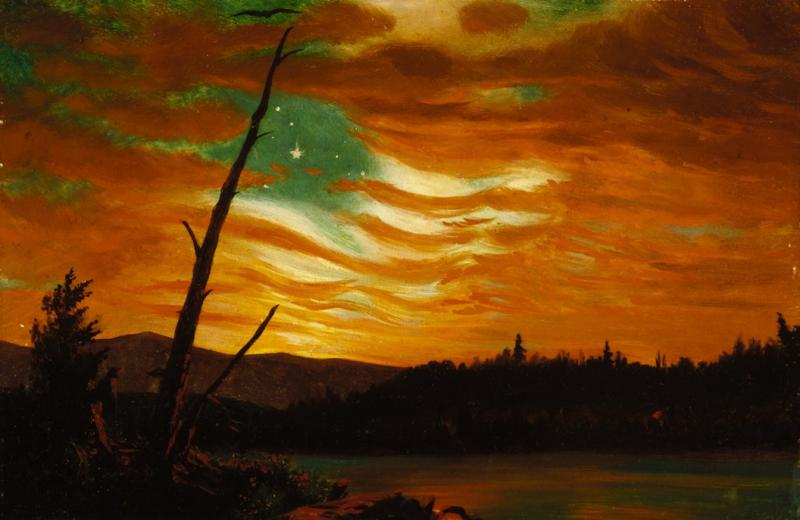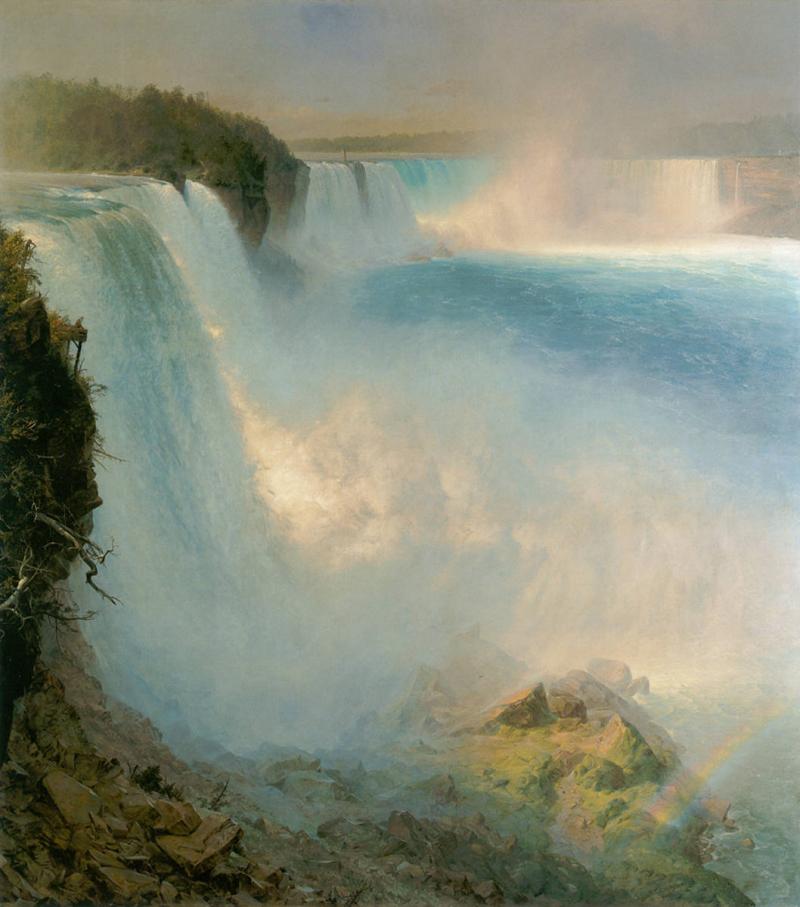Through American Eyes: Frederic Church and the Landscape Oil Sketch, National Gallery | reviews, news & interviews
Through American Eyes: Frederic Church and the Landscape Oil Sketch, National Gallery
Through American Eyes: Frederic Church and the Landscape Oil Sketch, National Gallery
The elements portrayed with passion, detail and fluency by the 19th century's heir to Turner

Pre-Raphaelites, eat your heart out; and wherever he is, John Ruskin, once so dismissive of the artist, must be beaming with pleasure. The American landscape painter Frederic Church (1826-1900) was indeed seen as the heir to Turner, and his distinct landscape idiom is encapsulated by a handful of oil sketches – just over two dozen – of scenes from the Hudson River Valley to Petra, Ecuador to Newfoundland, Bavaria to Salzburg, Jamaica to Labrador.
It is enough to give a tantalising glimpse of his extraordinary fluency with colour, texture and composition, at the service of a passionate response to landscape. He sought the spiritual in art, sometimes a little portentously. His much larger and smoothly finished showpieces (not on show here) made him one of the most wildly successful painters of his period, but 21st-century taste undoubtedly prefers the glittering intensity of these sparkling sketches.
“Of all employments I find this the most delightful,” he remarked of sketching in oil out of doors, and he produced hundreds. The controlled exuberance and enthusiastic tenacity with which natural features are portrayed in these closely-observed scenes are almost hypnotic in their effect. Scudding clouds, glowing sunsets, rippling water, icebergs radiating light, a fiery volcano and the rising sun are amongst his subjects. In small compass, vistas can be as grand as floating icebergs, the blue mountains of Jamaica and the Bavarian Alps, or as humble as a campfire in the Maine woods.
 Church indeed paid conscious homage to the ideas of John Ruskin. He visited England and studied Turner at the National Gallery, but his only major painting in the UK, the large scale Niagara Falls, from the American Side, 1867 (pictured right), is in the National Gallery of Scotland. It has made its way from Edinburgh to London for this show, and is complemented by four vivid oil sketches of the subject. Looking at these torrents of water casting off glittering rainbows, and roaring past brilliantly delineated rock cliffs, you can practically hear the staggering noise of the cascades, and feel the spray.
Church indeed paid conscious homage to the ideas of John Ruskin. He visited England and studied Turner at the National Gallery, but his only major painting in the UK, the large scale Niagara Falls, from the American Side, 1867 (pictured right), is in the National Gallery of Scotland. It has made its way from Edinburgh to London for this show, and is complemented by four vivid oil sketches of the subject. Looking at these torrents of water casting off glittering rainbows, and roaring past brilliantly delineated rock cliffs, you can practically hear the staggering noise of the cascades, and feel the spray.
As someone who has visited more than half of the sites Church depicts, it’s possible to testify that, as a realist landscape painter with a mesmerising attention to detail, he uncannily captures the feeling of these vast landscapes with more than a hint of the sublime, as well as relatively modest subjects such as The Forest Pool. Here you can almost sense the variegated degrees of softness and hardness when you walk on the mulch of the forest floor, and the glinting light that flickers on the plants that form the woodland carpet.
Graceful ferns, in a multiplicity of tones of greens and browns, are a concatenation of curves choreographed by an unseen wind in Fern Walk, Jamaica. This entrancing sketch was painted during a turbulent time, when Church and his wife were recovering from the sudden death of their young son and daughter from diphtheria; whilst Isabel Church was collecting ferns for their great garden surrounding their purpose built mansion, Olana, on the bank of the Hudson, the artist immortalised the scene. It was framed and kept in their home, where it still hangs.
Church was famous in London in the 19th century but British holdings of 19th-century American art are negligible and American art of the period is rarely sighted here. This small, perfectly formed show in Gallery 1 of the National continues their recent exploration of the subject, and complements their own European landscape oil sketches on view across the lobby in Gallery 46.
Share this article
Add comment
The future of Arts Journalism
You can stop theartsdesk.com closing!
We urgently need financing to survive. Our fundraising drive has thus far raised £49,000 but we need to reach £100,000 or we will be forced to close. Please contribute here: https://gofund.me/c3f6033d
And if you can forward this information to anyone who might assist, we’d be grateful.

Subscribe to theartsdesk.com
Thank you for continuing to read our work on theartsdesk.com. For unlimited access to every article in its entirety, including our archive of more than 15,000 pieces, we're asking for £5 per month or £40 per year. We feel it's a very good deal, and hope you do too.
To take a subscription now simply click here.
And if you're looking for that extra gift for a friend or family member, why not treat them to a theartsdesk.com gift subscription?
more Visual arts
 'We are bowled over!' Thank you for your messages of love and support
Much-appreciated words of commendation from readers and the cultural community
'We are bowled over!' Thank you for your messages of love and support
Much-appreciated words of commendation from readers and the cultural community
![SEX MONEY RACE RELIGION [2016] by Gilbert and George. Installation shot of Gilbert & George 21ST CENTURY PICTURES Hayward Gallery](https://theartsdesk.com/sites/default/files/styles/thumbnail/public/mastimages/Gilbert%20%26%20George_%2021ST%20CENTURY%20PICTURES.%20SEX%20MONEY%20RACE%20RELIGION%20%5B2016%5D.%20Photo_%20Mark%20Blower.%20Courtesy%20of%20the%20Gilbert%20%26%20George%20and%20the%20Hayward%20Gallery._0.jpg?itok=7tVsLyR-) Gilbert & George, 21st Century Pictures, Hayward Gallery review - brash, bright and not so beautiful
The couple's coloured photomontages shout louder than ever, causing sensory overload
Gilbert & George, 21st Century Pictures, Hayward Gallery review - brash, bright and not so beautiful
The couple's coloured photomontages shout louder than ever, causing sensory overload
 Lee Miller, Tate Britain review - an extraordinary career that remains an enigma
Fashion photographer, artist or war reporter; will the real Lee Miller please step forward?
Lee Miller, Tate Britain review - an extraordinary career that remains an enigma
Fashion photographer, artist or war reporter; will the real Lee Miller please step forward?
 Kerry James Marshall: The Histories, Royal Academy review - a triumphant celebration of blackness
Room after room of glorious paintings
Kerry James Marshall: The Histories, Royal Academy review - a triumphant celebration of blackness
Room after room of glorious paintings
 Folkestone Triennial 2025 - landscape, seascape, art lovers' escape
Locally rooted festival brings home many but not all global concerns
Folkestone Triennial 2025 - landscape, seascape, art lovers' escape
Locally rooted festival brings home many but not all global concerns
 Sir Brian Clarke (1953-2025) - a personal tribute
Remembering an artist with a gift for the transcendent
Sir Brian Clarke (1953-2025) - a personal tribute
Remembering an artist with a gift for the transcendent
 Emily Kam Kngwarray, Tate Modern review - glimpses of another world
Pictures that are an affirmation of belonging
Emily Kam Kngwarray, Tate Modern review - glimpses of another world
Pictures that are an affirmation of belonging
 Kiefer / Van Gogh, Royal Academy review - a pairing of opposites
Small scale intensity meets large scale melodrama
Kiefer / Van Gogh, Royal Academy review - a pairing of opposites
Small scale intensity meets large scale melodrama
 Jenny Saville: The Anatomy of Painting, National Portrait Gallery review - a protégé losing her way
A brilliant painter in search of a worthwhile subject
Jenny Saville: The Anatomy of Painting, National Portrait Gallery review - a protégé losing her way
A brilliant painter in search of a worthwhile subject
 Abstract Erotic, Courtauld Gallery review - sculpture that is sensuous, funny and subversive
Testing the boundaries of good taste, and winning
Abstract Erotic, Courtauld Gallery review - sculpture that is sensuous, funny and subversive
Testing the boundaries of good taste, and winning
 Edward Burra, Tate Britain review - watercolour made mainstream
Social satire with a nasty bite
Edward Burra, Tate Britain review - watercolour made mainstream
Social satire with a nasty bite
 Ithell Colquhoun, Tate Britain review - revelations of a weird and wonderful world
Emanations from the unconscious
Ithell Colquhoun, Tate Britain review - revelations of a weird and wonderful world
Emanations from the unconscious

Comments
Telling the Pre-Raphaelites
Telling the Pre-Raphaelites to eat their heart out may be an eye-catching opener, but it is stupid and sloppy, because it attributes a jealous mentality to the group which is unwarranted without supporting evidence, and provides only one heart among them. It is cliched to have clouds "scudding", and things small "perfectly formed". These elements mar a review which is otherwise fairly responsive, make it read like the work a hack in a hurry.